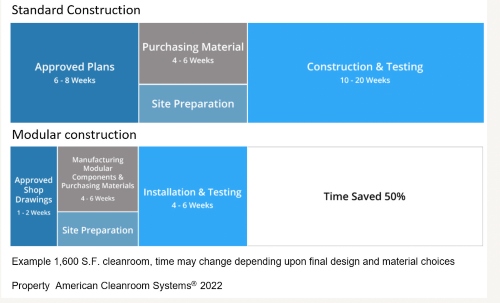In 1985 I was a young semiconductor engineer, PC’s had monochrome screens, 256k RAM and 8-bit microprocessors. We were building cleanrooms by screwing FRP to sheet metal studs (now referred to as standard construction). Fast forward 37 years and in 2022 customers have the additional choices of modular cleanroom construction and more recently PODs.
Modular cleanrooms use prefabricated components and dedicated installers significantly reducing the time to build a cleanroom. A dedicated design build modular cleanroom company is typically responsible for all elements of the modular cleanroom project. In contrast for standard construction the cleanroom is designed by architect who passes it on to general contractor as part of the overall project. The general contractor puts the different elements – drywall, ceiling, filtration, HVAC, electrical, flooring, and testing out to bid and the subcontractors work serially to complete the project. As a result, using modular cleanroom technology can significantly shorten time necessary to build one’s cleanroom.
Modular cleanrooms are very flexible. The modular customer can choose from a broad selection of modular panel walls surfaces including vinyl, melamine, FRP, painted aluminium and stainless steel. Modular wall core options include honeycomb, aluminium honeycomb, polystyrene core with gypsum sandwich, and polyiso-urethane foam. Key considerations for customer choice include cost, chemical resistance, static dissipative characteristics, fire resistance, sound insulating, heat insulating, and moisture resistance. Floor to ceiling windows is also an option with modular cleanrooms.
The modular wall system uses anodised aluminium base channel, connecting posts, cap channel and corner posts
The standard construction cleanroom wall is often epoxy painted gypsum board on steel studs. Other standard construction options include lining the gypsum board walls with FRP or aluminium sheets.
The modular wall system uses anodised aluminium base channel, connecting posts, cap channel and corner posts. These components form the structural backbone of the modular cleanroom. The connecting post typically includes internal electrical raceways for electrical wiring and mounting of electrical switches, convenience outlets and data ports. The anodised aluminium provides good chemical resistance for weekly or daily cleanroom wipe downs.
Modular cleanrooms utilise a negative pressure plenum to circulate air to the HEPA fan filter units which remove contamination from the cleanroom. The roof deck which forms the top of the plenum also services as a structural element to hang the cleanroom ceiling grid, cleanroom lights and HEPA fan filters units. In many cases the AC system is placed on the roof deck (top of the cleanroom).
Standard built cleanrooms most commonly use ducted HEPA fan filter units instead of a negative pressure plenum. This approach requires periodic balancing and grows very expensive if the cleanroom has a large number of HEPA fan filter units.

Modular cleanroom installation is quick and clean as all components are precut to size at the factory. There is no cutting or painting on the jobsite. This is important as often the modular cleanroom is going into an active factory environment and customers want to minimise the disruption on going production.
Other benefits of modular cleanrooms are future expansion or modification are easier as the cleanroom modular walls can be quickly disassembled and re-installed in different or larger configuration. Also, in the United States modular cleanrooms are often classified as equipment enclosures to qualify for better tax treatment.
Adoption of modular cleanrooms has gradually ramped up at a slow but steady pace. The pace was limited by several factors. Most architects do not receive significant education on modular construction and do not utilise it on a regular basis, so architect driven designs tended to be standard construction. General contractors are very experienced with standard construction and have established subcontractors for drywall, ceiling, and mechanical trades. Often the cleanroom is a smaller portion of the overall construction project, and the general contractor does not want to add another trade or subcontractor.
Modular cleanrooms utilise a negative pressure plenum to circulate air to the HEPA fan filter units
PODS are a further evolution of the modular construction concept. Instead of just using 4’x10’ wall panels and roof deck, PODS are typically 40’x8’ sections built in the factory and assembled on-site. Advantages are fast on-site construction. However, the large size of the sections means more structural elements have to be added to the design to allow them to be transported raising the cost. The primary users of PODS to this point have been pharmaceutical manufacturers who are less price sensitive.
Standard construction cleanrooms are still quite common. Especially for lower class cleanrooms where cost is the primary driver or when speed of installation is not a critical driver. However today the customer has the choice of modular, PODS and standard construction for his/her new cleanroom.
